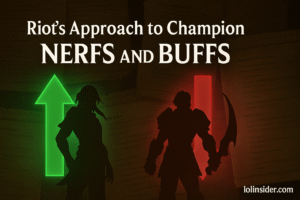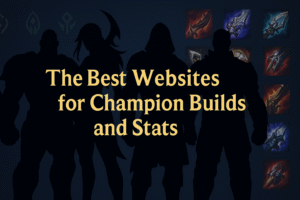The clash between early game vs scaling has always been central to League of Legends strategy. Some teams and players thrive by snowballing games in the first 15 minutes, while others rely on late-game compositions that come online after 30 minutes. Deciding which approach is better has sparked endless debates among pros, analysts, and casual players alike.
In this article, we’ll break down the strengths, weaknesses, and current meta trends that define the early game vs scaling debate in competitive and solo queue play.
⏱️ What Is an Early Game Composition?
Early game comps are built to dominate the laning phase, secure objectives, and end games quickly before opponents can scale.
Key Traits:
- Strong early laners (Renekton, Draven, Elise).
- High kill pressure and snowball potential.
- Early Dragon and Herald focus.
- Goal: end by 25 minutes or build an insurmountable lead.
Advantages:
- Momentum is on your side.
- Forces enemy mistakes with constant pressure.
- Easier to punish scaling teams before they reach spikes.
Weaknesses:
- If snowball fails, late game becomes nearly unwinnable.
- Reliant on clean execution and early coordination.
🌌 What Is a Scaling Composition?
Scaling comps are designed to survive the early game and thrive in the late game with superior teamfighting power.
Key Traits:
- Champions with powerful level/item spikes (Kassadin, Kayle, Jinx).
- Prioritize farming and avoiding early losses.
- Heavy emphasis on Baron/Dragon Soul fights.
- Goal: survive early, dominate late.
Advantages:
- Stronger teamfights at 30+ minutes.
- Forgiving in early mistakes—comeback potential.
- Excel in long macro games where scaling carries take over.
Weaknesses:
- Vulnerable to early dives and pressure.
- Easily snowballed if laners fall too far behind.
📊 The Current Meta: Early Game vs Scaling
The Season 15 meta has sparked renewed debate.
- Pro Play: Teams often blend both approaches. Early skirmish power in jungle and bot lane ensures objective control, while at least one scaling carry (often mid or ADC) provides insurance for late-game fights.
- Solo Queue: Snowballing early game champs dominate lower ranks, but scaling champions thrive in higher ranks where coordination is stronger.
🏆 Champions Defining the Debate
Early Game Power Picks
- Lee Sin / Elise (Jungle): Early gank pressure.
- Renekton (Top): Lane bully that controls objectives.
- Draven (ADC): Can snowball games off one or two kills.
Scaling Monsters
- Kassadin (Mid): Explosive power at level 16.
- Kayle (Top): Weak early but nearly unstoppable late.
- Jinx (ADC): Hypercarry that takes over extended fights.
🔑 When to Choose Early Game vs Scaling
- Pick Early Game If:
- Your team has strong early jungle pressure.
- Enemy draft includes weak laning champions.
- You want faster games (good in solo queue).
- Pick Scaling If:
- Your lanes can survive without winning early.
- You trust your team’s coordination for late fights.
- You’re in pro play or high elo where macro is more controlled.
🧠 Pro Perspectives
- LCK Style: Korea often favors scaling, trusting disciplined play to reach late-game teamfights.
- LPL Style: China thrives on aggression, often drafting for tempo and snowballing.
- LEC/LCS: Western regions mix both, with some teams preferring scaling insurance but experimenting with aggressive picks.
📝 Final Thoughts
The early game vs scaling debate will never fully end—both strategies are valid, and the better one depends on execution, draft, and context. The current meta rewards hybrid approaches, where teams secure early tempo without sacrificing late-game insurance.
For solo queue players, the lesson is simple: play to your strengths. If you like aggression, pick early game champions and push the tempo. If you prefer patience, scale up and trust your late-game carries.







